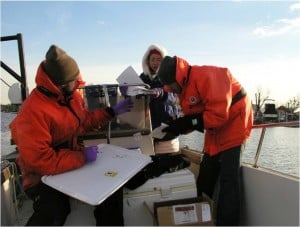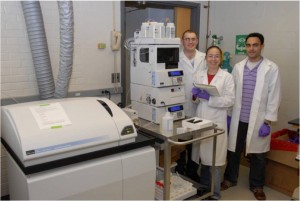Biogeochemistry of metals in contaminated sediments
Note: The work described on this page represents a combination of completed projects and ongoing research. Please refer to our Publications page for a list of published articles.

Contamination of sediments with organic and metal pollutants is a widespread environmental problem that poses serious risk to aquatic ecosystems. Bouwer group members working in the area of metals biogeochemistry seek to understand the physical, chemical, and biological processes that govern the fate and transport of metals across the sediment-water interface.
Our primary focus has been on metal speciation, transport, and bioavailability within sulfidic sediments common to estuaries such as the Chesapeake Bay. In the Baltimore Harbor, an industrialized subestuary of the Chesapeake Bay, contamination with numerous organic and metal pollutants has led to sediment toxicity at many locations throughout the Harbor, but the causative agents have not been clearly established.
Chromium Speciation and Redox Transformations in Sediments
Chromium is a common sedimentary contaminant, owing to its widespread use in a variety of industrial applications, including stainless steel production (corrosion inhibition), pigmentation, and tanning. In the environment, chromium exists in either the trivalent (+III) or hexavalent (+VI) oxidation state, with Cr(VI) being considerably more mobile, bioavailable, and toxic than Cr(III). Chromium ore mining and processing activities in the Baltimore area began in the 1820s and continued through the mid 1980s, resulting in significant releases of Cr to the environment. Chromium-containing waste materials were disposed of at numerous locations throughout the Baltimore area, and are potential ongoing sources of both Cr(VI) and Cr(III) to the aquatic environment.

The Bouwer group uses recent trace element speciation techniques such as HPLC-ICP-MS to quantify metal speciation in environmental media. Our survey of Cr distribution and speciation in Baltimore Harbor sediments and porewaters revealed elevated total Cr concentrations but little to no toxic Cr(VI), suggesting in-situ reduction of Cr(VI) to Cr(III). Further work in our lab demonstrated that rates of Cr(VI) reduction in Harbor sediments correlate with acid volatile sulfide (AVS, a measure of dissolved sulfide species plus minerals FeS and Fe3S4) content. Kinetics and stoichiometry of Cr(VI) reduction by synthetic pyrite were also investigated, and we found that pyrite is capable of rapidly reducing Cr(VI). Our data suggest that measures of AVS and total reduced sulfur (AVS + pyrite) should be incorporated into exposure assessments for Cr in sediments, since chromium contamination in highly reducing sediments is likely to be in the relatively non-toxic Cr(III) form.
Another Bouwer group project assessed whether the observed reduction of Cr(VI) to Cr(III) in Harbor sediments was likely to be a permanent process. Manganese (III,IV) (hydr)oxides are the principal naturally occurring oxidants of Cr(III), but elevated levels of these manganese minerals are unlikely to be present in anaerobic sediments rich in AVS. However, low-sulfide environments, sediment resuspension events or aerobic microenvironments generated by benthic organisms could provide opportunities for manganese (III,IV) (hydr)oxides to form and re-oxidize Cr(III) to Cr(IV). Through a series of laboratory experiments with natural sediments, we tested how factors such as the sediment’s redox buffering capacity, the porewater pH, and the organic matter content affected Cr(III) stability and Cr(VI) reoccurrence after its reduction under anoxic conditions. We examined the rates of Cr(III) oxidation and Cr(VI) reoccurrence in both natural sediments and synthetic manganese minerals (hydroxides and sulfides). These studies showed that manganese sulfides may play an important role in chromium redox cycling in estuarine environments.
Arsenic Speciation in Sediments
Speciation of arsenic in sediment porewaters is of interest as arsenic mobility, bioavailability, and toxicity depend on the particular form of arsenic (As(III), As(V), organoarsenic species, thioarsenic species). Our laboratory has applied HPLC-ICP-MS techniques for the determination of As speciation at the low µg/L level in Baltimore Harbor sediment porewaters. Results indicate that thioarsenic species are the dominant dissolved arsenic species at many locations in the Baltimore Harbor. Factors that affect thioarsenic species formation include pH, sulfide and polysulfide concentrations, and availability of reactive Fe (sulfide sequestration through formation of Fe-S minerals). Little is known about the toxicity of these thioarsenic species relative to other inorganic arsenic species (arsenite or arsenate) or organoarsenic species (monomethylarsenate, dimethylarsenate, etc.). Our occurrence results demonstrate the need for additional research detailing the fate, transport, and toxicity of thioarsenic species in aquatic environments.
